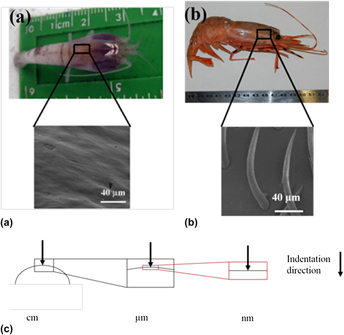Crossref Citations
This article has been cited by the following publications. This list is generated based on data provided by
Crossref.
Verma, Devendra
Exner, Matthias
and
Tomar, Vikas
2016.
An investigation into strain rate dependent constitutive properties of a sandwiched epoxy interface.
Materials & Design,
Vol. 112,
Issue. ,
p.
345.
Verma, Devendra
Qu, Tao
and
Tomar, Vikas
2017.
Mechanics of Biological Systems and Materials, Volume 6.
p.
17.
Verma, Devendra
Prakash, Chandra
and
Tomar, Vikas
2017.
Interface Mechanics and its Correlation with Plasticity in Polycrystalline Metals, Polymer Composites, and Natural Materials.
Procedia Engineering,
Vol. 173,
Issue. ,
p.
1266.
Verma, Devendra
Prakash, Chandra
and
Tomar, Vikas
2017.
Handbook of Nonlocal Continuum Mechanics for Materials and Structures.
p.
1.
Prakash, Chandra
Verma, Devendra
Exner, Matthias
Gunduz, Emre
and
Tomar, Vikas
2017.
Challenges in Mechanics of Time Dependent Materials, Volume 2.
p.
93.
Hu, Ruize
Prakash, Chandra
Tomar, Vikas
Harr, Michael
Gunduz, Ibrahim Emre
and
Oskay, Caglar
2017.
Experimentally-validated mesoscale modeling of the coupled mechanical–thermal response of AP–HTPB energetic material under dynamic loading.
International Journal of Fracture,
Vol. 203,
Issue. 1-2,
p.
277.
Prakash, Chandra
Emre Gunduz, I.
and
Tomar, Vikas
2018.
Fracture, Fatigue, Failure and Damage Evolution, Volume 7.
p.
7.
Sahu, Santosh Kumar
Badgayan, Nitesh Dhar
Samanta, Sutanu
and
Rama Sreekanth, P.S.
2018.
Quasistatic and dynamic nanomechanical properties of HDPE reinforced with 0/1/2 dimensional carbon nanofillers based hybrid nanocomposite using nanoindentation.
Materials Chemistry and Physics,
Vol. 203,
Issue. ,
p.
173.
Prakash, Chandra
Gunduz, Ibrahim E.
and
Tomar, Vikas
2018.
Effect of Interface Chemistry on the Interface Shock Wave Rise Time in Energetic material using Cohesive Finite Element Method.
Böhm, Corinna F.
Feldner, Patrick
Merle, Benoit
and
Wolf, Stephan E.
2019.
Conical Nanoindentation Allows Azimuthally Independent Hardness Determination in Geological and Biogenic Minerals.
Materials,
Vol. 12,
Issue. 10,
p.
1630.
Verma, Devendra
Prakash, Chandra
and
Tomar, Vikas
2019.
Handbook of Nonlocal Continuum Mechanics for Materials and Structures.
p.
361.
Sakthi balan, G.
Nandha Gopan, S.
Santhosh kumar, V.
and
Ravichandran, M.
2020.
Effect of chemical treatment on mechanical properties of prawn antenna reinforced waste plastic particulates filled polymer composites.
Materials Today: Proceedings,
Vol. 33,
Issue. ,
p.
3668.
Shubham
and
Ray, Bankim Chandra
2024.
Fiber Reinforced Polymer (FRP) Composites in Ballistic Protection.
p.
127.
Cho, Boongho
Seo, Hyein
Hong, Junyoung
Jang, Sook-Jin
and
Kim, Taewon
2024.
Exoskeletal Trade-off between Claws and Carapace in Deep-sea Hydrothermal Vent Decapod Crustaceans.
Integrative And Comparative Biology,
Vol. 64,
Issue. 1,
p.
80.
Taylor, Jennifer R A
Astbury, Mia
Childers, Elizabeth C
Contractor, Kanisha
Lin, Xinyu
Mencarelli, Jenna
Prohroff, Elisa J
and
Tapia, Kendra
2024.
Time-dependent Changes in Shrimp Armor and Escape Kinematics under Ocean Acidification and Warming.
Integrative And Comparative Biology,
Vol. 64,
Issue. 2,
p.
322.



